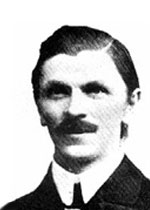Maroczy Geza (29.05.1951)
 Hungarian Grandmaster (1950). He is considered to be one of the strongest chess players at the beginning of the twentieth century.
Hungarian Grandmaster (1950). He is considered to be one of the strongest chess players at the beginning of the twentieth century.
Maroczy began to play chess at the age of 15, often playing with Rudolf Charousek. He studied engineering at Zurich Polytechnic. In 1895 on the recommendation of Emanuel Lasker, he played in the Hastings Amateur Championship where he took the first place and became a Master of the British Chess Federation. In 1896 he was second at Nuremberg, followed by S. Tarrash and Nelson Pillsbury behind Emanuel Lasker, and ninth at Budapest. He showed his best achievements in Vienna (1899-1900), Munich (1900), Monte Carlo (1902, 1904) Ostend (1905), Barmen (1905), and Vienna (1908), being first. In 1899 in London, he shared second place with David Janowski and Nelson Pillsbury, in 1900 in Paris he took third place behind Emanuel Lasker and Nelson Pillsbury, in 1903 at Monte Carlo he came in second place ahead of Nelson Pillsbury and Karl Schlechter, in 1907 at Carlsbad he performed as second also.
During the period 1900-1908 he played 189 games and lost only 17. In the 1920s, he continued to take part in international chess events and he came first in Amsterdam in 1922, in Hastings in 1924, in Carlsbad in 1923, and in Budapest in 1932.
His best result at the Olympiad was 9/12 points on the 1st board in London in 1927.
He played 12 matches, e.g., in 1896 he defeated Rudolf Charousek with a score 7:3, and in 1921 he drew a match with Max Euwe 6:6.
Before returning to Hungary in 1927, he lived in exile for seven years, first in the Netherlands, and then in England and USA.
Several times he was awarded brilliancy prizes for the beauty of play.
After World War II in 1946, he left for Amsterdam but reached only Vienna; even later he again had to come back to Budapest.
He was the author of some chess works: in 1908 he published Magyar sakktortenet with his autobiography and collection of games. His book Paul Morphy was published in German in 1909. He is a chess player of positional style. His chess views are based on the ideas of Tarrasch. He made a great contribution to the opening theory, and some innovations to the French Defence, Sicilian Defense, and the Queen’s Gambit.



